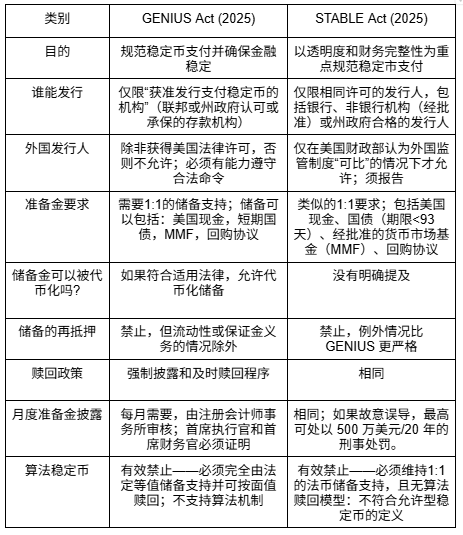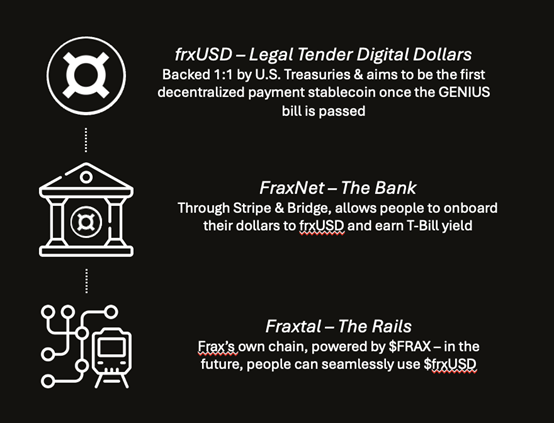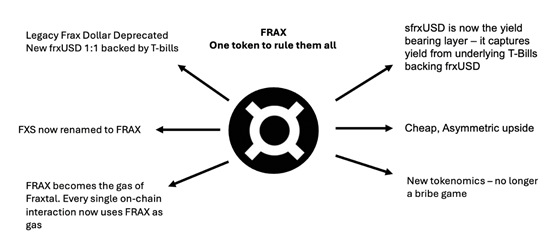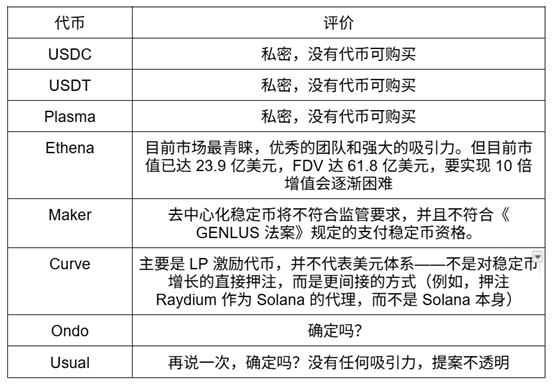Viewpoint: Why is FRAX the best investment target for stablecoin narrative?

Reprinted from panewslab
05/15/2025·25DAuthor: Kyle , Encrypted KOL
Compiled by: Felix, PANews
Note: Encrypted KOL Kyle currently holds FRAX; this article only represents Kyle's personal views and does not represent the views of PANews.
Key points:
- Market capitalization of US$276 million / circulating market capitalization of US$304 million; Frax provides an excellent asymmetric opportunity for betting on stablecoins, and with the upcoming GENIUS Act, Frax aims to be one of the first payment stablecoins in compliance with U.S. law
- Founder Sam Kazemian is involved in drafting US stablecoin legislation, and FRAX has a certain degree of regulatory compliance
- Asymmetric layout: regulatory environment with wind + product-market-regulatory fit + undervalued tokens (muched)
- FRAX has now become a vertically integrated stablecoin stack: frxUSD (stablecoin), FraxNet (banking interface), Fraxtal (L2 execution layer)
- frxUSD is fully backed by U.S. Treasury and cash
- Token restructuring: FXS is renamed FRAX, now Gas, governance, destroy and pledge tokens; the old version of frax USD has been deactivated, now frxUSD
- Valuation is undervalued: Compared with similar projects such as Ethena (US$6.1 billion), it has a market value of about $304 million, and is the best liquidity token exposure in the stablecoin narrative. USDC/USDT has no tokens (private companies), and Maker/Curve is not direct enough
- Real-world integration is available online: hosting services are available through BlackRock/Superstate, with partners including Stripe and Bridge
Let’s talk about the obvious issues first. The first reaction people hear about FRAX is hesitation—usually because it’s too complicated, trying to do “too many things,” or having a bad experience in trading FRAX before.
Before reading this article, I urge you to completely abandon any past bias against FRAX and treat it as open as possible. Pretend that this is your first time understanding – Frax has been completely changed as a completely different application, with its transformation meaningful and completely changing its direction.
1. FRAX is expected to capture the upcoming wave of stablecoins
Stablecoin narratives are well-known and recognized by every cryptographer to have a huge potential market (TAM). Nevertheless, it is rare to see talk about the GENIUS & STABLE Act—two landmark bills proposed by the U.S. Congress that defines the legislation of stablecoins. Why is this happening? This is because politics is an extremely difficult process, full of obstacles. People have low expectations for results and think it is nothing more than a trivial matter. Most people think these bills are quite important, but lack a basic understanding of their importance. Optimistically, they believe that it is a good thing that the stablecoin bill can be passed smoothly; pessimistically, they expect many delays and will eventually end up in nothing.
However, these bills are crucial to reshaping the future of stablecoins. Here is a comparative summary of the two bills:

There are two very important contents of these two bills:
First, they define payment stablecoins at the legal level. The GENIUS Act will formally allow payment stablecoins (PS) issuers to issue digital dollars that comply with the law as a medium of bank settlement and to use interbank payments in the U.S. and even global financial systems.
Payment stablecoins are the biggest structural change that level the playing field for innovation and opens the entire trillion-dollar U.S. banking door for stablecoin startups. Currently, the market value of US$200 billion stablecoins accounts for only 1% of the M1 money supply. The U.S. Stablecoin Act establishes payment stablecoins as a legal M1 digital dollar for the first time. In other words, the era of great stablecoins is about to begin.
Secondly, the bill is of great significance, creating a framework for federal standards regulation of stablecoins, and more importantly, it will become the standard for global stablecoin issuance. Today, stablecoins are in a legal gray area - in the United States, there is currently no real stablecoin regulatory framework. This prevents traditional participants from truly integrating stablecoins, and makes it difficult for existing participants to reach their full potential. This bill changed all of this, so it will really ring the bell of the great era of stablecoins.
Today, several crypto people in Washington, D.C. are helping to draft the landmark bill—Frax’s Sam Kazemia is one of them.
This is no longer just a DeFi protocol, but a monetary institution that has taken compliance into consideration before relevant regulations have been passed. Frax is now ready for legal expansions, legally, institutionally and globally.
FRAX: Introducing global M1 currency to stablecoins
Next, let’s talk about Frax’s current construction situation. Frax is not just building a stablecoin, it is building a complete monetary system that integrates TradFi and DeFi into a unified system, with the goal of obtaining the global M1 money supply. Frax achieves this by building a vertically integrated architecture covering issuance, income and settlement (the three pillars of the modern banking system), which consists of three parts:
- frxUSD – legal digital currency
- FraxNet – Bank
- Fraxtal – Channel

1. frxUSD: legal currency digital USD
frxUSD is Frax's flagship stablecoin—a digital dollar fully backed by short-term U.S. Treasury bonds and cash equivalents 1:1. It should be noted that this is completely different from the stablecoins before Frax - frxUSD was designed to comply with the requirements of the GENIUS Act and become a payment stablecoin (which is why Sam spent a lot of time in Washington).
frxUSD is fully backed by cash and short-term Treasury bonds and is escrowed through BlackRock and Superstate (BUIDL and UStb). frxUSD is committed to becoming the first payment stablecoin in the United States with fiat currency characteristics, compliant reserve structure and institutional integration.
2. FraxNet: Bank
If frxUSD is US dollar, then FraxNet is the banking interface. FraxNet is basically a stablecoin banking application – fully KYC certified, custodial compliance requirements, but native to the chain. Imagine logging into your account, checking your Goldman Sachs money market fund holdings, using it to mint frxUSD, and then flowing the earnings back to your Fraxtal address in real time.
The goal here is simple: convert the USD from every traditional money market fund (MMF) into an interoperable on-chain dollar. Frax has partnered with Stripe and Bridge to achieve this – which shouldn’t be surprising given Stripe’s recent announcement of stablecoin integration.
This is exactly what Frax is exciting about — a stablecoin pegged to real-world assets, targeting a trillion-dollar potential market.
3. Fraxtal: The execution layer of stablecoin business
Finally, let’s talk about Fraxtal, the native chain of Frax. frxUSD will be issued, transferred and settled natively on Fraxtal. Fraxtal is hard forked from Optimism Bedrock, has native bridging capabilities like Circle's CCTP, and is optimized for frxUSD as an accounting unit.
Fraxtal also uses FRAX (formerly FXS) as its Gas token—which means that every application built on Fraxtal, from FraxLend to FraxSwap to Frax Name Service, requires FRAX to run. Not only that, the fees incurred by these applications will be used directly to purchase and destroy FRAX.
FRAX may have gotten rid of its old identity as a decentralized stablecoin. Instead, FRAX is building a complete stack currency system that includes:
- frxUSD is a legal and compliant stablecoin
- FraxNet is the institution bridge and user entry layer
- Fraxtal is the global executive layer
This is a convergence of cash flow, practicality and growth. And what is most exciting is the efforts Sam has put in to make it meet regulatory requirements. At present, no other decentralized stablecoin issuer is embarking on this compliant, transparent and legal path.
At a time when everyone is paying attention to stablecoins, the next wave of massive adoption (the real, trillion-dollar wave) will come from institutions and consumers who need to comply with the law. They need a redemption. They need clear rules. They need to be able to walk into the boardroom and say, “Yes, this is in line with U.S. law.”
This is the embodiment of the compatibility of products, markets and supervision.
2. Refactoring of FRAX
Let’s talk about some of the subtle changes FRAX has experienced recently, which have added more help to the protocol. This section mainly introduces the changes made in FIP-428.

in short:
- The old version of Frax stablecoin has been deprecated and is now renamed Legacy Frax Dollar. The new stablecoin is now named frxUSD.
- FXS is renamed to FRAX – with only one core asset to represent the entire protocol.
- veFXS is renamed to veFRAX, wFXS is renamed to wFRAX, and so on.
- However, as exchanges are working to support this shift, it takes time.
- FRAX will become the Gas of Fraxtal, replacing frxETH. Now all on-chain interactions use FRAX as Gas. Moreover, the plan ultimately supports the use of FRAX for validator staking, which will greatly improve the practicality of the token.
- New Token Economics: Dead Issuance Plan – 8% issuance per year, decreasing by 1% per year until the lower limit of 3%. Issues are now allocated through FXTL points, a point system that rewards protocol-compliant points.
- You can use Flox Capacitors to increase conversion rates, which requires staking FRAX. The goal here is very clear: reward long-term users who lock, stake and actively participate in the ecosystem.
- This also means that there are no more FXS instruments—there are no more profitable LP mining; no longer issuing large amounts of tokens to maintain TVL—everything is made by earning.
- Frax is no longer a bribery game – now more like an L1 token that gets a currency premium, destruction, gains and utility than a bribery + mining token – which makes FRAX eligible for repricing.
- sfrxUSD is now the layer that generates revenues – it reaps the revenue from the underlying Treasury bonds that support frxUSD.
Of course there are some other key points. FIP-428 is a brilliant proposal that binds the entire ecosystem to the only token: FRAX. Every part of the Frax system is now back into the tokens; what is Fraxtal's fee? Burn FRAX. FXTL release? Only users who hold and stake FRAX can obtain it. Future verifier stake? Requires FRAX. Governance? veFRAX. Most importantly, FRAX is now an L1 token because it is a native Gas token on the chain.
Frax essentially creates a currency cycle with internal needs, practicality and consumption mechanisms. Personally, the key here is to understand that this is more than just a simple rebranding. Frax is becoming the most regulatory-compliant dollar stack in the crypto space that generates profits and is vertically integrated.
3. Of all liquidity tokens, FRAX is the best choice
Finally, let’s talk about its advantages. As we all know, stablecoins are the most popular product in the crypto field, serving the largest potential market
- that is, the world. The narrative of stablecoins is very clear, but in order to seize this opportunity, there are very few tokens available for investment.
Personally, Frax is the best liquidity token to bet on stablecoin narratives, with huge room for upward gains. In addition to the “North Star” upgrading and building the entire banking system, Frax is at the best position in the value chain of stablecoins.
The reason is simple: compared to other participants (whether it is DEX, lending market or payment applications), the issuing can obtain the largest economic share. Controlling is a huge value driver, and can make the most profits - as people say, whoever grasps the distribution channels is the winner.
That's why from an investment standpoint, USDC/USDT is the most popular product on the market today - but unfortunately they don't have tokens. Here is a comparison table with other liquidity tokens showing why Frax is the best token in today's liquidity market that represents the philosophy of stablecoins:

FRAX, on the other hand, was almost completely diluted, with a market cap of $276 million and a full dilution valuation (FDV) of $304 million as of May 10. This is a token that has a partnership with Bridge and Stripe, with a market capitalization of less than $500 million.
Secondly, it is a fact that FRAX's valuation is relatively low. As stated at the beginning, when introducing the project to people, they all show some degree of disdain. But everyone was wrong – I wasn’t surprised at all when I saw a chart like this, which is exactly the reason for buying – at the current price point, it’s an asymmetric investment with huge upside potential; if Sam could execute (and so far he did, having a partnership with all of these giants), the growth would be obvious.
4. Trading risk
Since we have finished talking about the upward space, let’s talk about the risks below. Actually, the risks here are very simple:
1. The stablecoin bill has been postponed, failed to pass, or changes affecting FRAX
In fact, this is happening—just a few days ago, the bill failed to pass in the U.S. Senate. However, here is quoted Sam, who has been working with these people over the past few months, said: "It's not as severe as people say. We never expect it to pass before Congress recession in August in late July. It's part of the political process and it's impossible to pass three months ahead of expectations. I'm an optimist, but not that optimistic either. Everything is still on track and is expected to pass in July, which has been my expectation."
July will be a critical month. If it still fails to pass, start worrying again. But before that, keep a calm mind.
2. Why are there a lot of talk about the GENIUS Act and few mentions of the STABLE Act? What if the STABLE Act was passed?
Again, this is not the case, according to Sam - both bills may be passed in their respective Houses, followed by a coordination period, during which a compromise final draft will be reached for the President to sign. The final draft is likely to be more like the GENIUS Act than the STABLE Act, and that's the key.
3. What is the worst situation?
Neither bill will pass—a situation that will probably only occur in a major disaster, such as a global financial collapse, when efforts by all parties will be completely shelved.
But the situation is not entirely dependent on the bill itself - Frax has shown great influence in improving the agreement, which I personally think is a good reason to bet on them.
4. Failed to fulfill the promise
Given that Sam has been all-out in Washington, D.C., the chances of this happening are extremely slim.
in conclusion
FRAX is no longer the "half-baked" (half-supported and half-unsupported) algorithmic stablecoin in 2022 in memory. It has evolved into a full-stack monetary system built around regulatory clarity, institutional collaboration and vertical integration. Founders assist policy makers in Washington, D.C. The stablecoin is backed by U.S. Treasury bonds and is escrowed by institutions. Tokens are gaining real utility – used as gas, governance, destruction mechanisms, and more.
The purest stablecoin bets in the crypto space are currently – and such opportunities are not often available. A token trading below $16 is directly pegged to the US dollar itself, the largest potential market in the crypto space. Looking forward to the future of FRAX.



 chaincatcher
chaincatcher